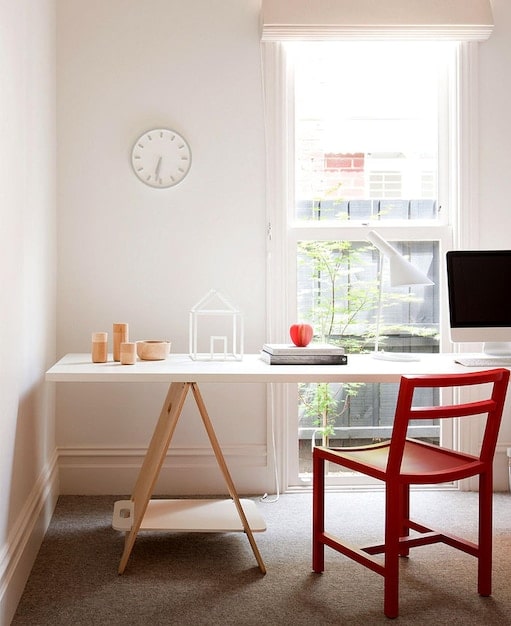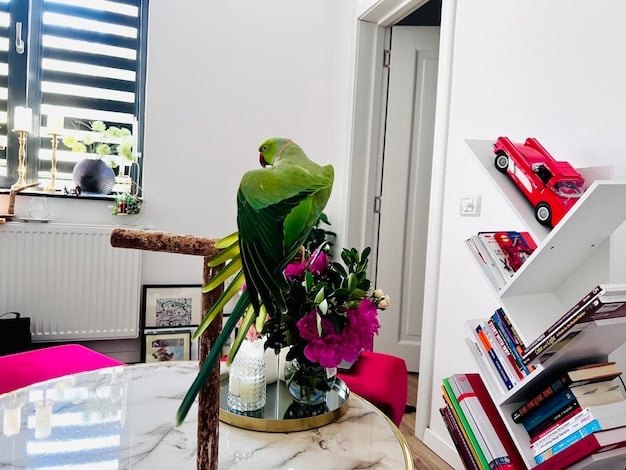Create Your Dream Home Office: A Guide to Dedicated Workspaces

Creating a dedicated workspace involves transforming any area into a functional and inspiring home office, enhancing productivity and focus through thoughtful design and organization.
In today’s work landscape, creating a dedicated workspace: transforming any room into a productive home office is no longer a luxury, but a necessity for maintaining focus, reducing distractions, and boosting overall efficiency. Whether you have a spare room or just a corner to spare, designing a space that caters to your specific work needs can significantly impact your daily performance and job satisfaction.
Importance of a Dedicated Workspace
Having a dedicated workspace is crucial for separating work life from personal life, especially when working from home. This separation helps to maintain a healthy work-life balance, preventing burnout and enhancing overall well-being. A well-defined workspace can also improve focus and concentration, leading to increased productivity.
Improved Focus and Productivity
A dedicated workspace minimizes distractions, allowing you to focus solely on your work tasks. When your workspace is organized and free from clutter, it becomes easier to concentrate and accomplish your goals efficiently. This focused environment can significantly enhance your productivity and the quality of your work.
Enhanced Work-Life Balance
Creating a dedicated workspace allows you to physically and mentally separate your work from your personal life. This separation helps to establish boundaries, making it easier to switch off from work at the end of the day and fully enjoy your leisure time. A clear demarcation between work and personal space contributes to a healthier and more balanced lifestyle.
- Reduces distractions by creating a focused environment.
- Improves concentration and efficiency in completing tasks.
- Helps to establish boundaries between work and personal life.
- Contributes to overall well-being by preventing burnout.
In conclusion, establishing a dedicated workspace is essential for optimizing productivity, maintaining a healthy work-life balance, and improving overall well-being. By thoughtfully designing and organizing your workspace, you can create an environment that supports your work needs and enhances your daily performance.
Choosing the Right Space
Selecting the right space for your home office is the first step in creating a productive workspace. Consider factors such as size, natural light, and noise levels when choosing your space. The ideal location should be free from distractions and large enough to accommodate all your essential work equipment.

Assessing Available Space
Start by evaluating the available space in your home. Consider rooms that are not frequently used, such as a spare bedroom, a large closet, or even a corner of a living room. Measure the dimensions of the space to ensure it can accommodate your desk, chair, and other necessary equipment.
Considering Environmental Factors
Pay attention to environmental factors such as natural light, ventilation, and noise levels. Natural light is essential for reducing eye strain and improving mood, so try to choose a space with access to windows. Good ventilation is also important for maintaining a comfortable and healthy work environment. Minimize noise levels by selecting a space away from busy areas of the house.
When choosing your space, consider whether it meets the following criteria:
- Sufficient size to accommodate your desk and equipment.
- Access to natural light for reduced eye strain.
- Good ventilation for a comfortable work environment.
- Minimal noise levels to reduce distractions.
In conclusion, choosing the right space is crucial for creating a productive and comfortable home office. By assessing your available space and considering environmental factors, you can select a location that supports your work needs and enhances your overall well-being.
Essential Furniture and Equipment
Selecting the right furniture and equipment is vital for creating a functional and ergonomic workspace. Invest in a comfortable chair, a sturdy desk, and any other essential equipment that supports your work tasks. Ergonomic furniture can help prevent physical strain and improve your overall comfort during long work hours.
Ergonomic Chair and Desk
An ergonomic chair is essential for maintaining good posture and preventing back pain. Look for a chair with adjustable height, lumbar support, and armrests. Pair your chair with a desk that is the appropriate height for comfortable typing and writing. Adjustable desks are a great option, allowing you to switch between sitting and standing throughout the day.
Essential Technology
Ensure you have all the necessary technology to support your work tasks, including a reliable computer, monitor, keyboard, and mouse. Consider investing in a second monitor to increase your screen real estate and improve productivity. A high-quality printer and scanner can also be useful for handling paperwork and documents.
- Invest in an ergonomic chair with adjustable features.
- Choose a desk that is the appropriate height for your body.
- Ensure you have a reliable computer and monitor setup.
- Consider additional technology such as a printer and scanner.
By investing in the right furniture and equipment, you can create a comfortable and efficient workspace that supports your work needs and reduces physical strain.
Optimizing Lighting and Ambiance
Lighting and ambiance play a significant role in creating a productive and inviting workspace. Proper lighting can reduce eye strain and improve mood, while a well-designed ambiance can enhance focus and creativity. Optimize your workspace with a combination of natural and artificial light sources.

Maximizing Natural Light
Natural light is essential for creating a bright and uplifting workspace. Position your desk near a window to take advantage of natural light. Use sheer curtains or blinds to control the amount of light and prevent glare on your computer screen. If natural light is limited, supplement it with artificial light sources.
Artificial Lighting Solutions
Choose artificial lighting that complements natural light and provides adequate illumination for your work tasks. Task lighting, such as a desk lamp, is ideal for providing focused light on your work surface. Ambient lighting, such as overhead lights or floor lamps, can create a warm and inviting atmosphere. Adjustable lighting allows you to customize the brightness and color temperature to suit your preferences.
Enhance your workspace ambiance with these lighting tips:
- Maximize natural light by positioning your desk near a window.
- Use task lighting to provide focused light on your work surface.
- Incorporate ambient lighting to create a warm and inviting atmosphere.
- Adjust lighting to suit your preferences and work tasks.
By optimizing lighting and ambiance, you can create a workspace that is both functional and visually appealing, enhancing your focus and creativity.
Organization and Storage Solutions
Effective organization and storage solutions are crucial for maintaining a clutter-free and productive workspace. A well-organized workspace reduces distractions and allows you to find essential items quickly and easily. Implement storage solutions that maximize space and keep your workspace tidy.
Decluttering Your Workspace
Start by decluttering your workspace, removing any unnecessary items that contribute to clutter. Organize your desk, drawers, and shelves, keeping only essential items within reach. Dispose of or relocate items that you rarely use to free up space and reduce visual distractions.
Storage Options
Invest in storage options that maximize space and keep your workspace organized. Shelves, drawers, cabinets, and storage boxes can help to keep your desk clear and your items neatly stored. Wall-mounted shelves are a great way to utilize vertical space, while under-desk drawers can provide additional storage without taking up valuable floor space.
Implement these organization and storage tips for a clutter-free workspace:
- Declutter your workspace regularly, removing unnecessary items.
- Utilitze shelves, drawers, and storage boxes to keep itmes organised.
- Use wall-mounted shelves to maximize vertical space.
- Label storage containers to easily identify contents.
By implementing effective organization and storage solutions, you can transform your workspace into a productive and efficient environment.
Personalizing Your Workspace
Personalizing your workspace can enhance your comfort and motivation, making it a more enjoyable place to work. Incorporate personal touches that reflect your personality and interests, such as artwork, plants, and decorative items. A personalized workspace can boost your creativity and overall satisfaction.
Adding Personal Touches
Incorporate personal touches that make your workspace feel like your own. Display artwork, photographs, or inspirational quotes that inspire you. Add plants to bring life and color to your workspace, improving air quality and creating a more relaxing atmosphere. Choose decorative items that reflect your personality and interests.
Creating an Inspiring Environment
Create an inspiring environment that stimulates your creativity and motivation. Surround yourself with items that bring you joy and encourage you to stay focused. Organize your workspace in a way that is both functional and visually appealing. A well-designed and personalized workspace can enhance your overall work experience.
Consider these personalization tips for your workspace:
- Display artwork, photographs, and inspirational quotes.
- Add plants to improve air quality and create a relaxing atmosphere.
- Choose decorative items that reflect your personality and interests.
- Organize your space in a way that is both functional and visually appealing.
Personalizing your workspace can transform it into a comfortable and inspiring environment that enhances your productivity and overall well-being.
| Key Point | Brief Description |
|---|---|
| 💡 Dedicated Space | Separate work and personal life for better focus. |
| 💺 Ergonomic Furniture | Invest in a comfortable chair and desk for posture. |
| ☀️ Lighting | Maximize natural light and use task lighting. |
| 🪴 Personalization | Add personal touches to enhance motivation. |
Frequently Asked Questions
▼
A dedicated workspace helps to separate work life from personal life, improving focus and reducing distractions. It also contributes to a healthier work-life balance and reduces the risk of burnout.
▼
Essential items include a comfortable ergonomic chair, a sturdy desk, a reliable computer, a monitor, a keyboard, a mouse, and adequate lighting solutions. Storage options like shelves and drawers are also important.
▼
To maximize productivity, minimize distractions, create a comfortable and organized environment, set clear boundaries between work and personal time, and incorporate personal touches that inspire you.
▼
Start by decluttering your workspace, removing unnecessary items. Utilize shelves, drawers, cabinets, and storage boxes to keep your desk clear. Label storage containers to easily identify contents and maximize vertical space.
▼
Personalize your workspace by adding artwork, photographs, plants, and decorative items that reflect your personality and interests. Create an environment that inspires you and makes you feel comfortable and motivated.
Conclusion
Creating a dedicated workspace is essential for enhancing productivity, maintaining work-life balance, and improving overall well-being. By choosing the right space, investing in ergonomic furniture, optimizing lighting and ambiance, implementing effective organization solutions, and personalizing your workspace, you can transform any room into a productive home office that supports your work needs and inspires your best performance.





